Emotionnal Intelligence
Introduction
- An ancient topic, as of yet barely analysed or studied
- First studies occurred in the early 90s
- Main pioneers: Mayer, Goleman…
- Popularised in the early 2000s with the appearance of the concept of QE
- Incorporated into operational models around 2010
According to Mayer emotional intelligence is defined as:
‘The ability to perceive and examine emotions, to integrate them into your thought process, to understand and reason with emotions, as well as to regulate the emotions of yourself and others.’

1 – Goleman’s model: 4 principal concepts:
- Self-awareness—this is the ability to understand your emotions, to recognise their influence and use them to guide our decisions
- Self-regulation—consists of controlling your emotions and impulses and adapting to changing circumstances.
- Social skills—encompasses the ability to detect and understand the emotions of others, and to react to them.
- Managing relationships—this focuses on the capacity to influence others in ways which further their interests and resolve conflicts.
2 – EQ: a measure of emotional intelligence:
- Your capacity to identify the feelings of yourself and others, to motivate yourself and to successfully control your emotions in your relationships with others.
- Your EQ is not fixed and improves with age and experience.
3 – The links between IE and business
The influence of our emotions influences:
- Our behaviour
- Our decisions
- Our strategies
- Our perceptions
- Our capacity to think
- Our opinions of others
The social environment is complex and multifaceted
- Everyone you come into contact with has control of their emotions to a greater or lesser extent.
- Interpersonal relations generate emotions.
- Our state of mind changes one day to the next and directly influences our actions.
- The emotional rollercoaster is an influential component of the sales cycle.
Understand and master emotional intelligence
4 – Basic Emotions
- Joy/serenity
- Anticipation/interest
- Disgust/boredom
- Sadness
- Anger
- Surprise
- Trust
No emotions are negative, but some are unpleasant
- Our feelings are the cognitive interpretations of our emotions
- The cognitive process is the sum of our psychological systems and activity, which produce conscious thoughts, instead of working within the realms of emotion.
4 – steps of understanding.
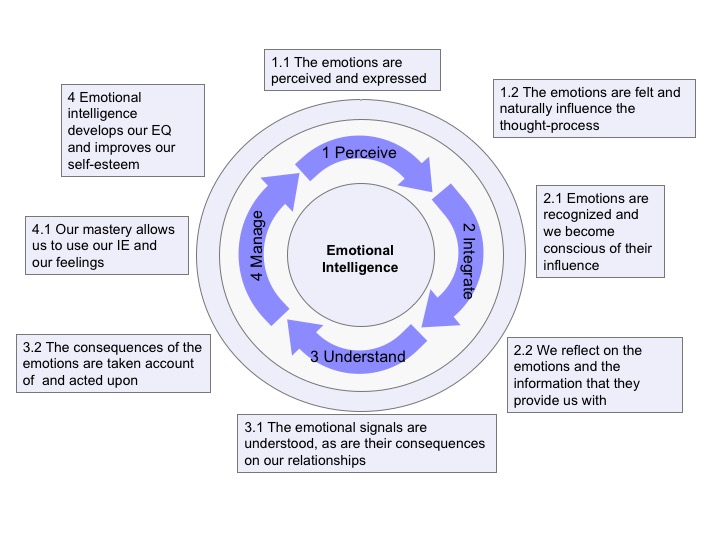
5 – Listen to the emotions
Locate that place within us where we express the emotions that we feel.
- When we are afraid, we feel the throat tighten or our stomach churn.
- When we feel extreme sadness, we feel as if we have taken a blow to the heart.
- When we are angry we feel hot pressure in our temples.
- When we feel pleasure we feel a warmth spread through our body.
Understand the logic behind emotions
- These stimuli have a direct impact on our behaviour.
- Learn to detect them before their effects take hold, this enables you to control them better and then decide whether to use them or not.
- This also allows you to anticipate the behaviour of others according to the emotions that they are feeling
The example of fear
- We distrust it, we mock it, yet fear is one of the most powerful emotions to push us to action.
- We all get frightened; when this happens, we try to ignore it and it becomes more and more insistent, to the point where it consumes us.
- But only a small part of our fear is centred on the present danger we are facing, the largest part comes from our own imaginations
- Thus, to tame our fears means, first, to listen to it, then to understand it, and finally use it as a source of motivation to help us act in the way we desire.
- The following step allows us to use the emotions of others as a persuasive tool, these are also powerful sales levers
This procedure is identical for the other primary emotions
6 – Control your emotions

Take a moment
- Control your breathing. Breath in, hold for 4 seconds, breath out. Repeat 4 times.
- Clear your mind
- Stop the flow of your thoughts
- Mentally call out your emotions by name
- Choose one and listen to it
Sorting the information coming from our bodies and holding them at arm’s length, so to say, allows us to improve our concentration, lucidity (reflectiveness) and our creativity (problem-solving). Maintaining a level of control over the
way
our
bodies express themselves has two advantages
- We are able to modify the information we convey.
- We can dampen the intensity of our emotional perception.
This stops us from handing over all of our faculties to the automatic mechanisms of our emotional system.
7 – 6 Ways to work on your IE
-
Self-esteem
- This describes the degree of acceptance and therefore the love that you have for yourself.
- If it is important to accept who you are, it is a necessity to love yourself and to cultivate your own self-esteem.
- Free yourself from the prejudices that you may hold about yourself, about your body, your mind and the shortcomings in your behaviour.
- Identify the deep feelings that we inspire in others, not only on a general basis but individual by individual.
- It is when we look at ourselves as a whole, encompassing our talents, our personality, our defects and our problems, that we learn to appreciate ourselves.
- To appreciate yourself helps you to understand your emotions, and mastering your emotions improves your self-esteem. It’s a positive feedback loop.
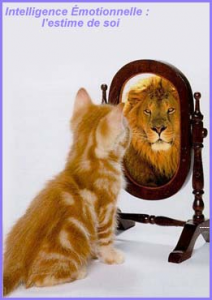
-
Self-confidence
- This measures that intimate feeling which tells you have the power to achieve your objectives in your life.
- It allows you to liberate yourself from your fears when you take on a new task.
- A lack of self-confidence breeds doubt and gets in the way of your peace of mind you should feel regarding your personal potential and your capacities.
- Self-confidence is indispensable when convincing and enticing people.
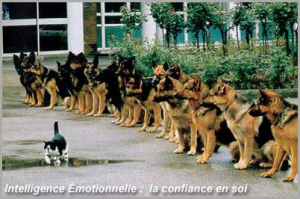
-
Motivation
- This represents the determination with which you pursue the goals you have set yourself in life.
- It’s your ability to push yourself onwards, a personal capacity to question yourself and the strong force of will required to reach your objectives.
- It stimulates and directs your thoughts, feelings, and acts.
- A lack in self-esteem can either be characterised by unrealistic and unchecked ambition, or an unnecessarily high level of defeatism.
- Setbacks are inevitable, knowing how to motivate yourself to bounce back more quickly and to persevere enables us to maximise our chances of achieving success.

-
Empathy
- It’s your talent for putting yourself in the shoes of others and interpreting their feelings, including the ones expressed non-verbally.
- This ability to understand the feelings of others allows you to predict and understand their thoughts, so you can anticipate their reactions, their doubts, and even their fears.
- This is a decisive professional ability, in the art of commercial negotiation or in management.
- A lack of empathy will limit you in your capacity to find win-win solutions.

-
Persuasion
- This is your capacity to convince others and gain their support without employing underhanded means like ruses, threats, or orders.
- It is intimately linked to your charisma.
- A strong capacity for persuasion underlines your authority, and allowsyou to succeed in gaining the support and loyalty of others.
- Conversely, without this ability you will have difficulties making your message heard and gaining the support of others.
- This ability holds legitimate power in the professional world where, between clients, prospects, collaborators, and managers, knowing how to convince is a near-perpetual concern.

-
Independence
- This is your skill for self-reflection and your capacity to apply the conclusions you have drawn, even if they don’t align with your pre-conceived notions.
- A strong capacity for independence allows you to forge an opinion stemming from your own rational or even emotional criteria.
- The inverse can mean that you are too susceptible to the influence of your immediate circle or of society in general.
- Be careful because a lack of independence is also the cause of that incapacity to change your point of view in the weight of new evidence.
- Independence of spirit reinforces the confidence that others have for you.

8 – Employing IE in the sales cycle
These different personal skills aligned with IE can be used more or less forcefully regarding the steps of the sales cycle and the objectives you need to achieve:
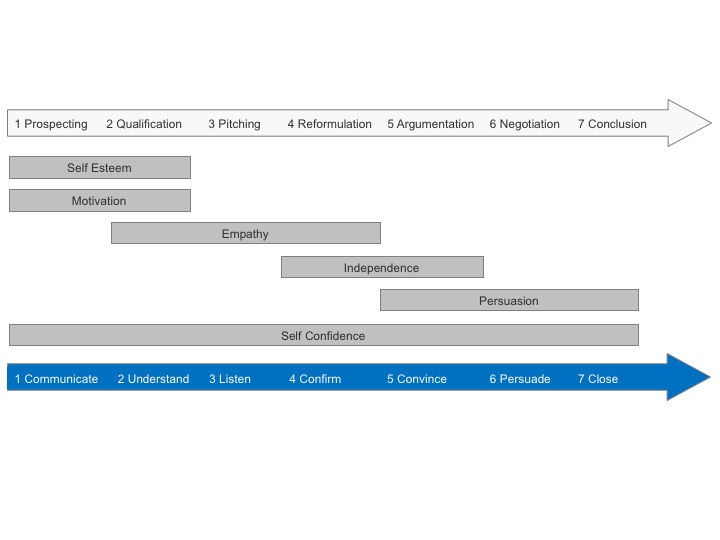
To help us we can use some physical tools
9 – The power map: a powerful tool.
The power map is a means of conceptualising the relationships between different actors within a sales cycle. The information needed for creating a power map are as follows:
- The actors, their hierarchical relationships and their functions.
- Their role in the sales cycle.
- Their colours (behavioural matrix).
- Their relationships and the influence they have on others.
- Locate the centre of power.

10 – Define the role and the key actors
Users:
- Use the solutions.
- Are influenced by the solutions.
- Can be involved in the sales process.
- Can exert an influence on the decision making process.
Signatories:
- Become involved when the project attains a certain level or is considered as a strategic project.
- The day-to-day level decisions are signed on if they seem to be typical and if the supplier has proved their reliability.
- Suppliers, technically in an inferior position can try to exert influence over the signatories to alter a decision.
Deciders:
- Make a decision based on the recommendations presented to them.
- Freedom to make a decision can be limited by budgetary or organisational decisions.
- Generally occupies a high position in the company.
Prescribers:
- Carry out a formal evaluation.
- Bring suggestions/objections to senior executives.
- Can belong to evaluation teams
11 – Define the colour of the actors: the disc method.
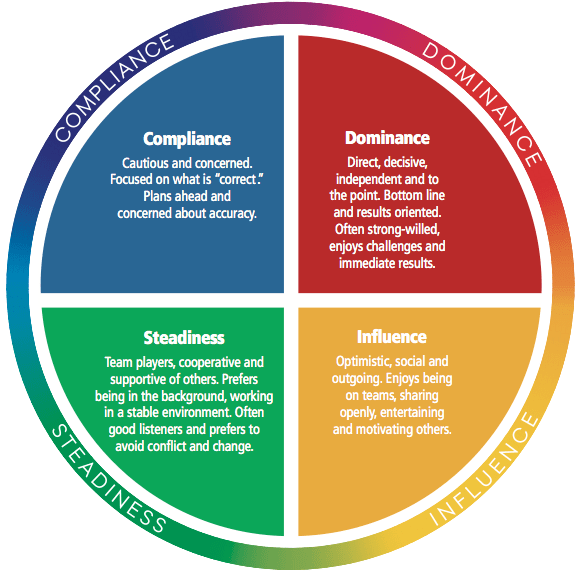
Quick, Energetic, Ambitious, Determined, Independant
Enthusiastic, Optimistic, Spontanious, Sociable, Talkative
Respectful, Attentive, Conciliatory , Patient, Reliable
Careful , Thoughtful, Organised, Analytical, Pragmatic
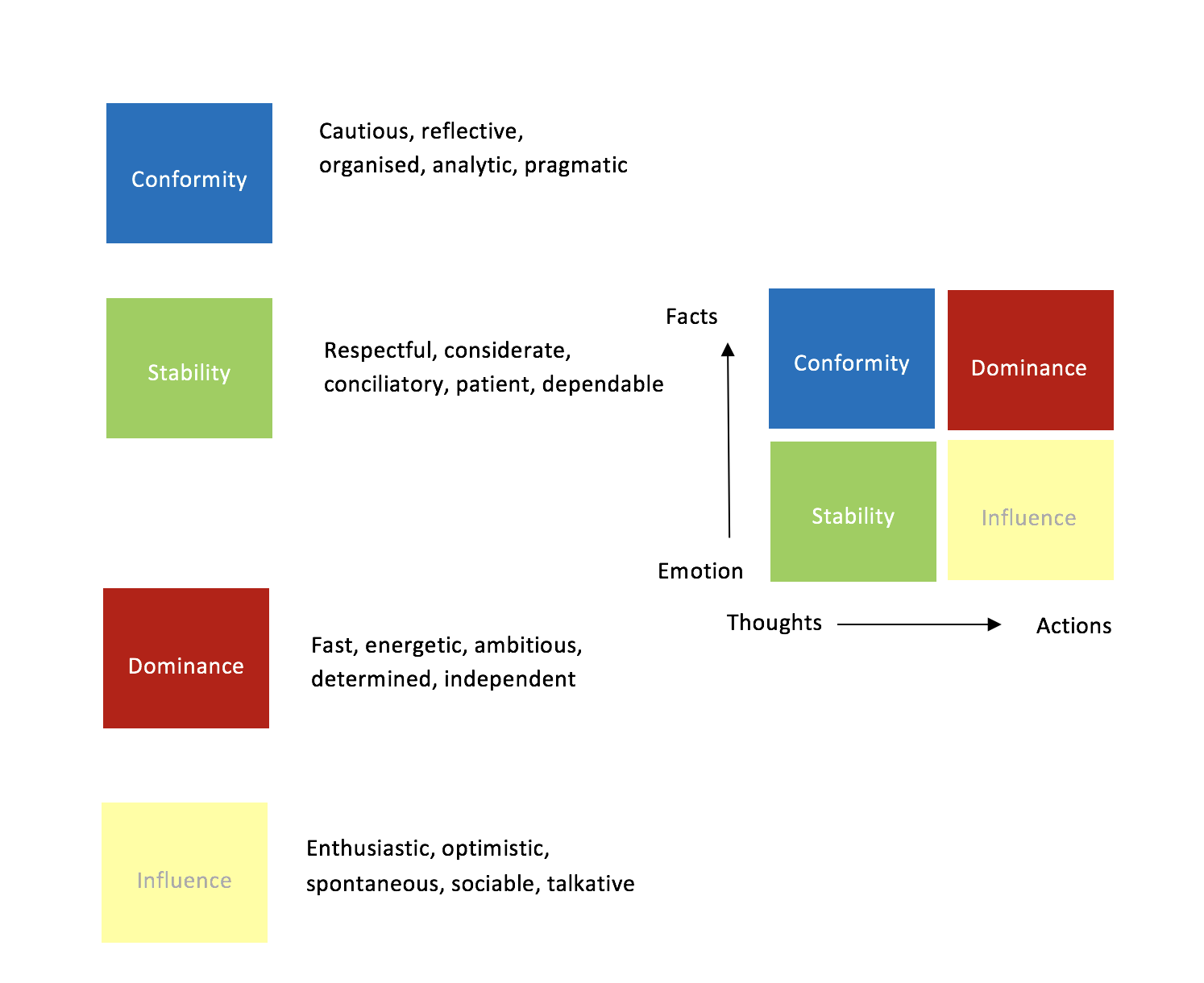
12 – Evaluate our influence on each actor
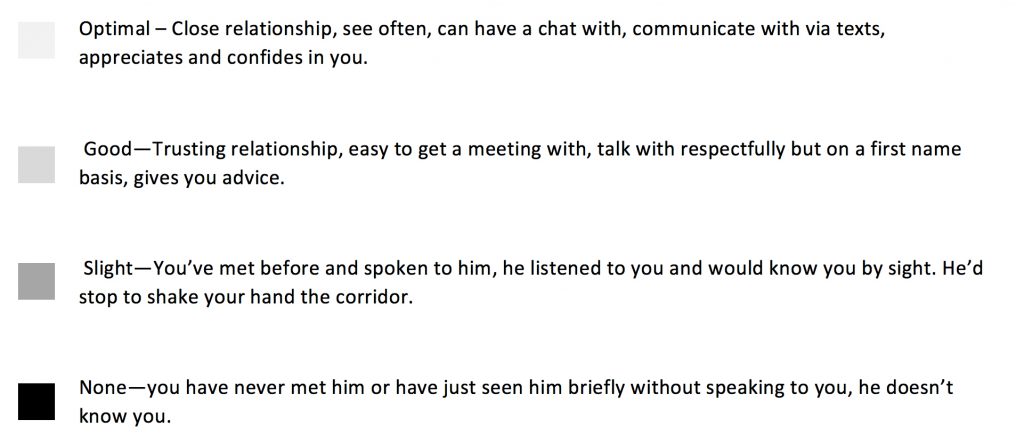
13 – Evaluate the influence of each actor
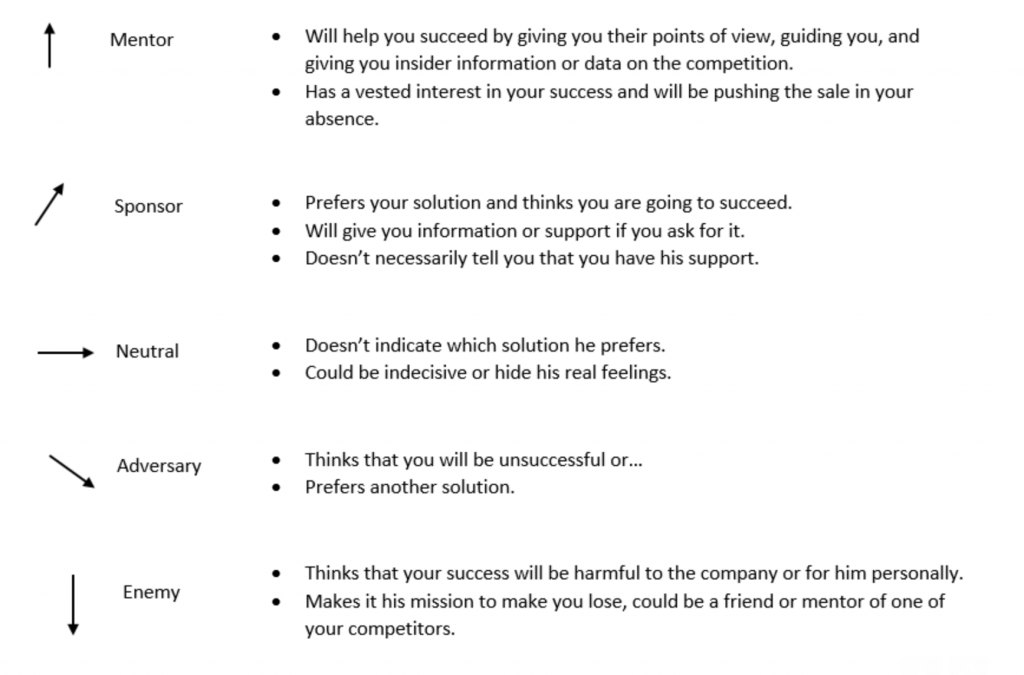
14 – Draw your powermap
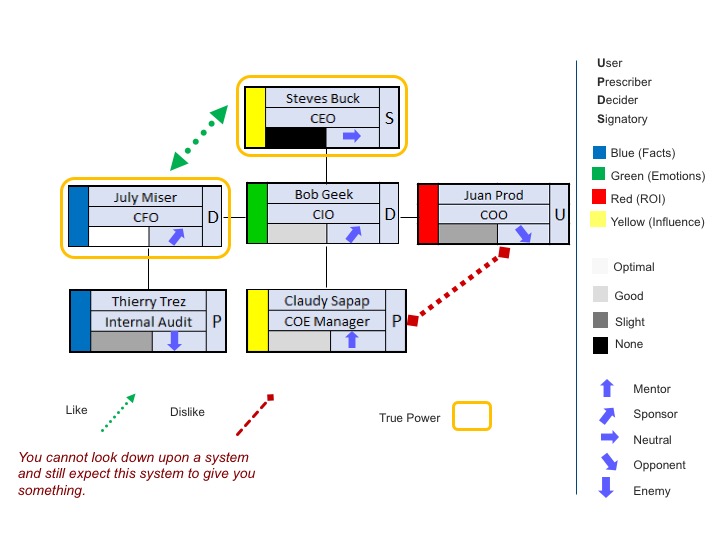
Successfully employ IE in the sales cycle
15 – Stage a play
- The sales cycle is a story to be staged.
- It is divided into scenes.
- You are simultaneously the director and the leading actor.
- It never represents reality.
16 – The Approach
- Your strategy defines the manner in which you should act.
- Your tactics determine the emotions that you will provoke.
- Your behaviour sets the scene in motion.
17 – Becoming an actor helps you to take a step back from your emotions
- You understand your own emotions more easily.
- You can control them more easily.
- You become more open to the emotions of others.
Your objective is to reach a state of ‘flow’, in other words to succeed in perfecting IE without effort and take pleasure from it. It is possible to feel this state when you play a sport at a high level and in an instant you start playing exceptionally well without the least effort.
- The 4 stages of IE: self-confidence, self-control, social conscience, and managing relationships.
- Emotions influence our behaviour directly and automatically.
- Control of IE can be achieved through: self-confidence, self-esteem, motivation, empathy, persuasion, and independence.
- Involving IE in the sales cycle can permit you to use your emotions as assets.
- The Powermap is a tool which can allow you to implement IE in your sales cycle.
- By understanding others and their emotions, you can modify your behaviour in order to influence them directly.
- The IE is a formidable power which can allow you to effectively control your professional environment and attain ‘flow’.

Envoyer un message
[contact-form-7 id="26" title="Formulaire de contact"]- Téléphone : 06.62.04.09.12
- Email : alexandre [at] mengual [dot] eu
